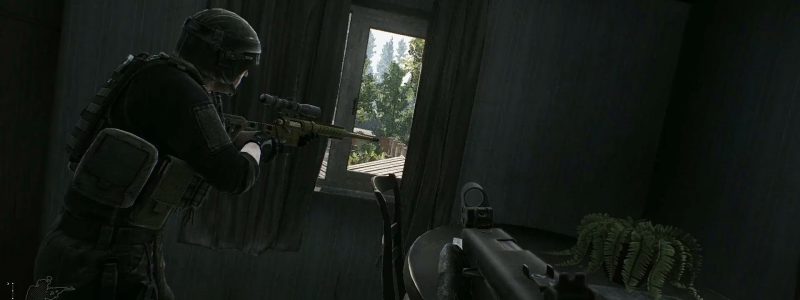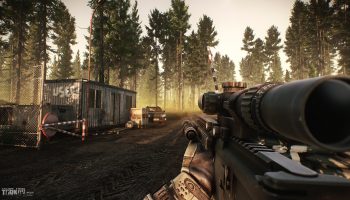This guide contains every possible setting I can think of to make your Tarkov experience a little bit better. I have 4200 hours in the game and enjoy messing with settings. I wanted to put everything that I’ve found together in one place. Hope it helps.
My build for reference: 3070 Ti, 5800x, 32gb DDR4 3600MHz, 1440p 144hz monitor. I currently average 110-135 fps on 1440p on most maps.
Sections
- Drivers
- In-game
- Windows/PC
- XMP
- Nvidia Control Panel
- AMD Radeon/Adrenalin
- Recommended downloads
- Audio
DRIVERS
Before doing anything else, I recommend starting by updating all of your drivers.
- Nvidia GPU
- Manually update NVIDIA drivers
- Manual Driver Search > Select your device from the list > Search > Scroll down > Download most recent ‘Game Ready’ driver (not the studio)
- Quick video explaining how to
- GeForce Experience
- This will automatically notify you when new update are available, and it makes it super easy to download/install
- Download with above nvidia link
- This also gives you the GeForce overlay, which includes the Recording/Instant Replay features, FPS counter, and a few other cool things
- I’ve personally had a few issues with GeForce Experience in the past, so I don’t use it anymore. It always lowered my performance a little bit, especially the recording option
- Manually update NVIDIA drivers
- AMD GPU
- Download the AMD software, which includes a driver tool (or manually download from the section below that) –
- AMD instructions on how to use the
- AMD Instructions on
- BIOS Drivers
- It’s probably worth updating your BIOS firmware if yours is super out of date. Be careful messing with the BIOS if you don’t know what you’re doing
- PCWorld instructions on
- Intel CPU (Chipset Drivers)
- Intel ()
- Intel ()
- AMD CPU (Chipset Drivers)
- AMD ()
- Download the automatic version at the top, or look below the download button, select ‘Chipsets’, then find your motherboard (It also may detect your mobo and give you an option to click and jump straight to that page)
- You can also update chipset drivers from the motherboard manufacturer’s website
IN-GAME
- Game
- The dropdown menus are all personal preference
- Automatic RAM Cleaner – OFF*
- Only use physical cores – OFF*
- *these will both be taken care of with free programs ISLC and Process Lasso, which are explained later – leave them off in game
- FOV – 64
- This is personal preference for the most part, but FOV does affect camera recoil AND eye relief (not sure that’s the correct term, but that’s how Tigz described it)
- Video from Tigz explaining how
- Head bobbing – 0.2 (all the way left)
- Malfunction notifications – ON
- Preload hideout – OFF
- Screenshot of
- Graphics
- Texture Quality – High
- Tarkov is dumb, lower quality textures can sometimes cause lower FPS. Try high first even if you’re struggling for FPS
- Shadows Quality – Low
- Bump this up if you want to, I don’t notice much of a difference
- Object LOD quality – 2.5
- Overall visibility – 1500
- Anti-aliasing – TAA High
- Resampling – 1x off
- NVIDIA DLSS – OFF
- I don’t know a single person who uses DLSS and likes it. I get a lot of visual ghosting with it.
- AMD FSR 1.0 – OFF
- Consider turning this on if you have a lower end PC or are struggling for FPS. It is kind of similar to DLSS in that it upscales. It is not restricted to Nvidia RTX cards and doesn’t have as many negative qualities as DLSS
- Here is a decent video on
- HBAO – High
- NASA PC – colored very high, great PC – high, medium PC – low/off, bad PC – off
- Makes everything look a lot nicer. Shadows/depth and stuff
- SSR – High
- Good PC – High, medium PC – low (if want visual effect), bad PC = off
- This is one area where I personally disagree with Vox_E’s guide. He says to leave this off, as it’s already technically enabled if you have textures on High. I’ve tested this myself and noticed a massive visual difference between Off and High (even between Off and Low when looking at water), and imo this is one of the most important settings to make tarkov look “good”. It even changes the look of water/reflections
- Anisotropic Filtering – Per texture
- Nvidia Reflex Low Latency – ON
- You can also choose ‘on + boost’ if you need better performance – my understanding is that it just keeps your GPU ramped up ready to go instead of making it ramp up and down as needed.
- Sharpness – 0.2
- Personal preference, can also change in nvidia control panel
- Lobby FPS Limit – 60
- Everything at the bottom – OFF
- Screenshot of ngs
- Texture Quality – High
- POSTFX
- Here are my personal (I also use Nvidia Control Panel for colors)
- Enabling POSTFX definitely lowers your FPS, but it makes tarkov not look like a dreary Russian wasteland, so I think it’s worth it. I also mess with colors in the Nvidia control panel.
- You can load into an offline raid, pull up POSTFX settings, and click “visualize” to make the menu screen transparent – then you can move the sliders around and view changes in real time
- Sound
- Overall – 100
- Interface – 30
- Chat – 100
- Music – 0
- Hideout – 0
- Music on raid end – On
- Binaural audio – On (explanation in audio section)
- VOIP – On
- Keybinds
- Mouse sensitivity/Mouse sensitivity (aiming)
- Personal preference (I use 0.6 for both, with 800 dpi mouse).
- Some people like to have the aiming (ADS) sensitivity lower
- Double click timeout – 0.3
- Reload faster
- Change ‘Emergency weapon reload’ – Control + R (and set to Press)
- If you keep this at ‘R’ set on double click, every time you try to reload normally the game will wait at least 0.3 seconds before actually reloading. This is because of the ‘Double click timeout’ setting, which is a minimum of 0.3 seconds. The game always waits that amount of time before doing the first action IF there is another action bound to double click of that same key.
- Explanation of the
- Bind multiple actions to the same key
- I don’t personally use these, but there are a couple of cheeky things you can do by binding multiple actions to the same key
- You do this by setting Action #1 to a key and changing the Press Type to ‘Press’. Then, assign Action #2 to that same key and change the Press Type to ‘Release’
- Video explaining how to
- Example uses:
- Mouse sensitivity/Mouse sensitivity (aiming)
- Tarkov launcher window
- Open Tarkov Launcher > Under your name in top right corner, click the dropdown and go to settings
- When I close the launcher window > Exit the Launcher
- When I launch the game > Exit the Launcher completely
XMP
- XMP is basically a preset overclocking profile for your RAM that will allow it to operate at the advertised speed. First, check to see if your RAM is running at full speed. If it’s not, then enable XMP in your BIOS.
- To check, open task manager (Control+Shift+Escape) > Performance tab > Memory
- Look at the speed. If it says 2133 MHz, or anything other than what your RAM should be, then you need to enable XMP in your BIOS.
- This is a great for various motherboard manufacturers, including ASUS, MSI, Gigabyte, and ASRock (Nov 2021)
WINDOWS/PC
- Mouse Acceleration – OFF
- PC Settings > Devices > Mouse > Additional Mouse Options > Pointer Options tab > Enhance pointer precision – OFF
- Monitor Refresh Rate
- PC Settings > System > Display > Click on the correct monitor > Advanced display settings > Refresh rate > Pick the highest number
- Power mode
- PC Settings > System > Power & Sleep > Additional power settings > Balanced
- You can try High Performance if you want, but here is a really interesting comment referencing an AMD spokesperson about (comment is specifically about AMD chips with Zen 3 architecture, 1 year old)
- PC Settings > System > Power & Sleep > Additional power settings > Balanced
- Disable Xbox
- PC Settings > Gaming > Xbox Game Bar > OFF
- Game Mode
- PC Settings > Gaming > Game Mode > ON
- PC Settings > Gaming > Game Mode > Graphics Settings > Hardware Accelerated GPU Scheduling – ON
- If you are having stuttering issues, you can try turning HAGS OFF to see if it helps.
- I’m not sure how much of a difference this makes in Tarkov, but I know that this setting caused issues in the past with some other games. I’ve also seen a lot of reports about this causing issues when ON if you are streaming
- Turn OFF surround sound
- PC Settings > System > Sound > under Output Device, click Device Properties > Additional Device Properties> Spatial Sound tab > OFF
- EscapeFromTarkov.exe Properties
- Locate your EscapeFromTarkov.exe file (mine is at C:Battlestate GamesEFTEscapeFromTarkov.exe)
- Right click > Properties > Compatibility tab > Disable fullscreen optimizations – ON
- On that same Compatibility tab > Change high DPI settings > Override high DPI scaling behavior – ON
- Make sure you hit Apply
- Now do the same with the EscapeFromTarkov_BE.exe file (disable full screen optimization, and override high DPI scaling)
- Pagefile
- I saw this suggested on Reddit a lot recently and recently made the change myself.
- I set my minimum to 12k and my maximum to 30k
- Instructions:
- (July 2022)
- (1 year ago)
- Discord
- Settings > Advanced > Hardware Acceleration – OFF (turn this ON if you get issues with discord/streaming while playing)
- Settings > Game Overlay > Enable in-game overlay – OFF
NVIDIA CONTROL PANEL (for Nvidia GPUs)
- Guides
- (January 2022)
- (August 2022)
- (May 2020)
- Manage 3D settings
- Open Nvidia Control Panel > Select ‘Manage 3D settings’ from the list on the left
- Click on the ‘Program settings’ tab
- Select ‘Escape from Tarkov.exe’ from the dropdown list of programs
- If you can’t find it, run the game in the background and then click the Add button
- Make sure not to select the BSG launcher
- Image Sharpening – Sharpen 0.5, Ignore Film Grain 0.17
- Vox_E had nothing, I use Trey24k’s settings, and Panjno had 0.2/0.13
- Anisotropic filtering – Application-controlled
- FXAA – OFF
- Gamma correction – ON (Vox_E has this off)
- Antialiasing Mode – Application controlled
- Antialiasing Transparency – Off
- Vox_E has this on Multisample, which does reduce some jagged edges at a very small resource cost
- Low latency mode – Depends
- Ultra – Nvidia Gsync monitor
- On – High refresh rate monitor
- Off – 60hz monitor
- Quick video explanation of and tradeoff between Latency/FPS
- MFAA – OFF
- Power management mode – Prefer maximum performance
- Vox_E prefers Normal
- Prefer Maximum Performance basically just keeps your GPU ramped up the entire time. Definitely keep this on if you need FPS, but you don’t really need it if you have a really good CPU
- Texture filtering – Anisotropic sample optimization – ON
- Texture filtering – Negative LOD bias – Allow
- Texture filtering – Quality – High performance
- Texture filtering – Trilinear optimization – ON
- Threaded optimization – ON (Vox_E has this off)
- Triple buffering – OFF
- Vsync – OFF
- Click Apply
- Adjust desktop color settings
- This is largely personal preference and depends a lot on your monitor and in-game settings. Some people use this instead of POSTFX. I personally use both.
- Go to the ‘Adjust desktop color settings’ section
- Select your gaming monitor
- Contrast – 55%
- Gamma – 1.4 (this helps with brightening up dark areas, but it can look weird on some monitors)
- Digital vibrance – 60-70% (mine is set to 65%)
- Set up G-SYNC (*Only for G-SYNC compatible monitors)
- Go to the ‘Set up G-SYNC’ section
- Select ‘Enable for windows and full screen mode’
- Enable settings for the selected display model – ON
- Click Apply
- Adjust desktop size and position
- Go to the ‘Adjust desktop size and position’ section
- Select your gaming monitor > click No Scaling > Perform scaling on: select ‘GPU’ from dropdown > check resolution/refresh rate
- Click Apply (your screen might flash + make you confirm changes again)
AMD Radeon/Adrenalin (for AMD GPUs)
- Panjno video with
- Another AMD video by Panjno that goes a little bit
- These are the best guides I can find, but they’re from May 2020. Things might have changed since then, but I was using these settings on my AMD system until I switched a few months ago
- Open AMD Radeon
- Gaming Tab > Global Graphics
- Graphics Tab:
- Radeon Anti-Lag – ON
- Radeon Image Sharpening – ON
- Sharpness – 20-50%
- Wait for Vertical Refresh – Always Off (he turns it ON in-game, and OFF here)
- Click Advanced
- Anti-Aliasing – Use application settings
- Anti-Aliasing Method – Multisampling
- Morphological Anti-Aliasing – OFF
- Anisotropic Filtering – OFF
- Texture Filtering Quality – Performance
- Surface Format Optimization – ON
- Tessellation Mode – Override application settings
- Maximum Tessellation Level – OFF
- OpenGL Triple Buffering- OFF
- Display Tab:
- Radeon FreeSync – OFF (can turn it on if you have a FreeSync monitor and are struggling with FPS)
- Virtual Super Resolution – OFF
- GPU Scaling – Disabled
- Scaling Mode – Full Panel
- Custom Color (right side) – Worth messing with if you want to add to or replace your POSTFX
RECOMMENDED DOWNLOADS
- ISLC – Intelligent standby list cleaner
- This replaces the Ram Cleaner setting
- – (I know the website looks sketchy af lol, it’s fine)
- Panjno video explaining
- Click stop
- List size is at least – 1024
- Free memory is lower than – 16000 (16k if 32gb ram, 8k if 16gb ram)
- Start ISLC … – ON
- Launch ISLC… – ON
- Enable custom timer resolution – ON
- Wanted timer resolution – 0.50
- ISLC polling rate – 500 (500 good PC, or 1000 lower end PC)
- Click Start, then Minimize
- Process Lasso
- Replaces the Use Only Physical Cores setting
- Video explaining Process Lass +
- Process Lasso > Options > General > Manage Processes of All Users – ON
- Process Lasso > Options > General > Close Window to System Tray – ON
- Process Lasso > Options > General > Refresh Interval (GUI) – 10s
- Process Lasso > Options > General > Refresh Interval (Governor) – 10s
- (*I ignore the High Performance power plan suggestion from the video because I have an AMD CPU that works better on Balanced)
- Open Tarkov > Open process lasso > locate the EscapeFromTarov.exe in Process Lasso > Right click on EscapeFromTarov.exe and make these changes:
- CPU-Z
- Neat little lightweight tool that will show you a lot about your system
AUDIO
- Surround Sound – OFF
- There is no surround sound in Tarkov. Turn off every single surround sound/3D audio program/setting you have when playing Tarkov – Instructions in the Windows section
- Binaural Audio – ON
- Apparently Binaural Audio is being removed at some point and replaced with something else. BSG blames steam audio for not integrating correctly or something like that, but it’s not working because Tarkov has spaghetti code. I’ve heard BSG is going to try and build something themselves, but who knows what will actually happen
- For now, I highly recommend enabling Binaural Audio (Steam Audio) in the game settings . It definitely has issues, but it is much better at directional audio. You will hear random pops and sounds though
- A lot of people have this off, and I didn’t use it for 3k hours. I switched to binaural last wipe and love it. Both are fine.
- Videos on how Tarkov audio works
- This is the best audio that I’ve ever heard (30 seconds) –
- Good video explaining in Trakov
- 3 hour (the steam audio section is only 7 minutes and includes a lot of direct gameplay comparisons between binaural on/off)
- Veritas’ original video on (June 2020)







